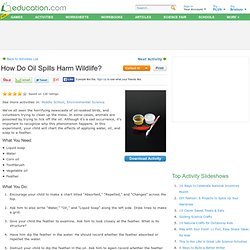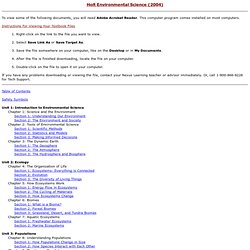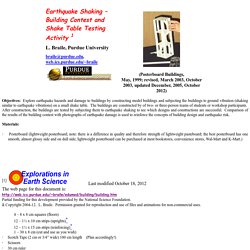

Gtm-media.discoveryeducation.com/videos/25624/C5C32927-B631-F575-1A3C976829BED60A.pdf. Www.epa.gov/espp/coloring/cbook.pdf. Robinmoore/files/2012/12/rock-cycle-worksheets.pdf. Calendar and Class Handouts/Worksheets. Teaching the Earth’s Layers and Plate Tectonics Using a 3D Model. Www.azpbs.org/mastersofdisaster/pdf/Earthquakes/Earthquakes_Level_2.pdf. Www2.hawaii.edu/~himbed/forms/HIMB-Ocean-Acidification-Lab.pdf. Resources/download/TheWaterProject-TeachingGuide-MSHS.pdf. Www.nrdc.org/oceans/acidification/files/labkit.pdf. Www.iowachildrenswaterfestival.org/PDF/WaterTriviaQuestions.pdf.
How Do Oil Spills Harm Wildlife? We've all seen the horrifying newscasts of oil-soaked birds, and volunteers trying to clean up the mess.

In some cases, animals are poisoned by trying to lick off the oil. Although it's a sad occurrence, it's important to recognize why this phenomenon happens. In this experiment, your child will chart the effects of applying water, oil, and soap to a feather. What You Need: Liquid soap Water Corn oil Toothbrush Vegetable oil Feather What You Do: Encourage your child to make a chart titled "Absorbed," "Repelled," and "Changes" across the top.
What's Going On? Feathers are constructed of strands of hair and miniature "hooks. " The type of oil carried by tankers is much harder to remove from birds' feathers, although it is important to try! Www.epa.gov/region1/students/pdfs/ww_disap.pdf. Www.globalwatershed.mtu.edu/docs/watershed_connections/Watershed_Connections_Lesson_2_Global_Water_Cycle.pdf.
Precipitation Education. Articles for Kids. Earthsys.ag.ohio-state.edu/ACES/ACES_curriculum_sections/ACES_MIDDLE_SCHOOL_ACTIVITIES/global_climate_game.pdf. Holt Environmental Science. Holt Environmental Science (2004) To view some of the following documents, you will need Adobe Acrobat Reader.

This computer program comes installed on most computers. Instructions For Viewing Your Textbook Files 1. Right-click on the link to the file you want to view.2. If you have any problems downloading or viewing the file, contact your Nexus Learning teacher or advisor immediately. Table of Contents Safety Symbols Unit 1: Introduction to Environmental Science Chapter 1: Science and the Environment Section 1: Understanding Our Environment Section 2: The Environment and Society Chapter 2: Tools of Environmental Science Section 1: Scientific Methods Section 2: Statistics and Models Section 3: Making Informed Decisions Chapter 3: The Dynamic Earth Section 1: The Geosphere Section 2: The Atmosphere Section 3: The Hydrosphere and Biosphere.
Saxonhomeschool.hmhco.com/ha/Resources/saxonhomeschool/Holt_EnviroScience_LP.pdf. Holt Environmental Science. Www.nps.gov/glac/forteachers/upload/Climate_change_MS-Unit_Final.pdf. Www.dnrec.state.de.us/DNREC2000/Divisions/AWM/aqm/education/airqualityLesson1.pdf. Edhd.bgsu.edu/~sbanist/611/final/heather/heatherecology1.pdf. Www.vcapcd.org/AirTheFilm/pubs/AirPollutionTragedyLessonPlan.pdf. Www.dnrec.state.de.us/DNREC2000/Divisions/AWM/aqm/education/airqualityLesson1.pdf. Www.starhop.com/library/pdf/studyguide/elementary/GloJar-7.pdf. Www.vcapcd.org/AirTheFilm/pubs/EffectsOfGlobalWarmingLessonPlan.pdf. Modules & Activies Main Page. Using climate science models and NASA satellite images and data sets, students apply problem-solving methods and scientific inquiry skills to address six climate-related scenarios.

More Each of the problem-based learning scenarios also includes teacher pages to help educators implement the modules into their classroom teaching. All of the materials are free. Our only request is that teachers register for the site to access the module-specific teacher pages and complete a post-event survey. More Login Whether you’re new to problem-based learning or have extensive experience using this type of instructional approach, we encourage you to view our problem-based learning pages.
The Exploring the Environment legacy modules include four variations on problem-based learning—activities, basic, comprehensive, and advanced. Scientists are explorers. Problem-based learning is designed to stimulate discussion within classes, among teachers, with scientists, and across communities. Www.educationfund.org/uploads/docs/Publications/Curriculum_Ideas_Packets/Density_Dynamic_Duo_of_Mass-and-Volume.pdf. The Habitable Planet: A Systems Approach to Environmental Science.
Www.middleschoolscience.com/density.pdf. Www.esc4.net/users/0205/INB_ELL.pdf. Www.misd.net/languageart/grammarinaction/501writingprompts.pdf. Science News For Kids. Space & Science Stories. News Archive. Articles for Kids. Life. Mie.democratandchronicle.com/sites/default/files/documents/Classroom_Newspaper.pdf. Mysteries Inquiry - Danielle Stinson.
Activity: Build an Earthquake-proof Structure. (Activity courtesy of MyScienceBox and Irene Salter).

Level: Grades 6-12. Time Required: Three class sessions: 1) to build the shake table (may be prepared ahead of time) and make preparations; 2) to build the tower structures; and 3) to test each structure. Group size: 2-4 students. Teacher handout: project_quake_towers.doc Earthquake-proof Structures Students in grades 6-12 construct towers out of drinking straws that must withstand simulated earthquakes vibrations and the increasing load of 250 gram sandbags. Objectives Students will: understand basic principles of earthquake engineering and design including the importance of a solid foundation, wide base, symmetrical design, and trusses.work together in a team to design and build a structure. follow through a design process of repeated designing, testing, redesigning and retesting a structure. Standards Grade 6 – Earth Science Plate Tectonics and Earth’s Structure 1.
Www.doe.virginia.gov/testing/sol/standards_docs/science/cf_final_web_version/framewk_earth science.pdf. Www.geo.mtu.edu/~jdiehl/ETM.pdf. Web.ics.purdue.edu/~braile/edumod/building/building.htm. Objectives: Explore earthquake hazards and damage to buildings by constructing model buildings and subjecting the buildings to ground vibration (shaking similar to earthquake vibrations) on a small shake table.

The buildings are constructed by of two- or three-person teams of students or workshop participants. After construction, the buildings are tested by subjecting them to earthquake shaking to see which designs and constructions are successful. Comparison of the results of the building contest with photographs of earthquake damage is used to reinforce the concepts of building design and earthquake risk. Materials: · Posterboard (lightweight posterboard; note: there is a difference in quality and therefore strength of lightweight pasteboard; the best posterboard has one smooth, almost glossy side and on dull side; lightweight posterboard can be purchased at most bookstores, convenience stores, Wal-Mart and K-Mart.)
Last modified October 18, 2012 The web page for this document is: Rules: